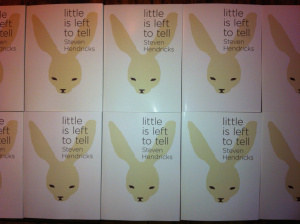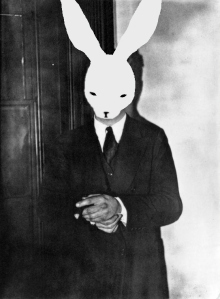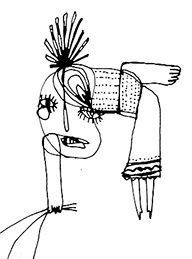Steven Hendricks's Blog
July 30, 2016
interview with Steven Hendricks, author of Little is Left to Tell
I've thought of myself as a writer since I was very young. I was trying to imitate Edgar Allan Poe in middle school and James Joyce in high school. In college, at Evergreen, I got serious about how to put words together well and how to enrich my writing with knowledge from other disciplines, and I delved into the history and theory of literature. It was always about fiction, never poetry or journalism, and I only ever really imagined working in long form.
- What inspires you to write?
I get excited about writing that can escape what I know or think—I try to write my way into formal or narrative situations that I couldn't have predicted. I'm also really motivated to write by discovering relationships between texts or between literary and historical figures. Fundamentally, though, I'm concerned with the potential beauty of language, the meaning that erupts from the artful combination of words—even when it doesn't quite make sense.
- What is your writing process like?
I begin with fragments, branching possibilities, and as I write I make discoveries about new narrative tensions or relations among characters. I took a very long time to work through different versions of Little is Left to Tell. I hope not to be so slow with my next book. In any case, it's a process of building from fragments, notecards, and narrative swatches into something that starts to take on a form that I couldn't have predicted. Once that form begins to coalesce, then I become part writer, part reader to my work, and I see where the interpretive process leads.
- Do you have a favorite book, (or genre of book) that you like to read and reread over again? Tell us about one of your favorite works.
As a teacher, I do a lot of re-reading by assigning the same books. Some I never get tired of are works by Samuel Beckett, Virginia Woolf, Italo Calvino, and Jorge Borges. On the more contemporary end of things, I adore Kazuo Ishiguro's novels and read David Mitchell for something light and fun. I like to think there's something in each of these authors that's identifiable as an aspiration in my work.
- As a writer, what kind of books do you like to read?
I love to read French literary theory, the poems of Mallarmé, biographies, works like Sebald's and Calasso's that overwhelm with a combination of narrative breadth and encyclopedic inventions and scholarship (real or invented). I'm also inspired by the work of the Oulipo.
- Little is Left to Tell weaves together fables, dreamlike images, and fairytale references. What do you find intriguing about these types of stories?
Freedom and play. The familiarity of such stories allows me to quilt them together into something unfamiliar without leaving the reader with nothing to hold onto. By creating stories that mirror and diverge from each other, I can construct a kind of fugue structure of narrative movements. Thematically, familiar stories of these types are the narrative structures that are pervasive in our thinking about our experience, especially our less-examined pasts. Playing with them in a literary text allows me to problematize narrative continuity and identity as part of the same ideological reality-consecrating processes.
- How did the idea of this book come to you?
Many pieces came together over the course of a decade (or two). The central narrative of Mr Fin and David was first, but it was missing something. I wanted to avoid giving them a tidy back-story, and I needed Mr Fin to confront the tension between story and the "blooming, buzzing" confusion of experience. I was leaning heavily on the confusion, and needed the presence of story to make the tension real. That's where the rabbits came in.
- You are a professor at the Evergreen State College. What inspires you in the classroom?
When students discover the truly enormous possibilities of human thought and creativity, the radical expanse of world literature that extends so far beyond the market-structured genre flavors pushed at them as teens, I see their minds open, their sense of hope increase, and their capacity to perceive the world in new ways expand. Creating the space in which they can achieve that is always the goal.
- Do you have any personal experience of family members with dementia or hallucinations? Are their personal connections in this book that you can tell us about?
These aspects of the novel come from my interest in my mother's family. I met my mother's mother when she was already incommunicative and nearly immobilized by alzheimer's. I also met her books, in which she'd made copious notes. Learning about her and through her books and eventually about her son, David, was part of the inspiration for the novel—a rifling through their lives and all the quiet legacies I couldn't quite grasp but that I knew were there.
- How did rabbits become such a central part of the storytelling here?
I started the rabbit story as a separate piece, based on the odd pictures and storyline in a 1950s era French language primer for children. Presumably for no other reason than our fascination with Alice in Wonderland, Watership Down, Beatrix Potter, Goodnight Moon, and other such iconic rabbits, rabbits occupy a special place in our collective image of childhood fancy. And of course, some of the characters emerged from bedtime stories I made up for my kids.
- Along with being an author, you are also a printmaker. How do you weave together these two art forms?
I came to letterpress printing and bookbinding as an extension of my writing. I wanted to experiment with full visual and tactile control of what writing could be, to explore the range of forms that the object that contains language could take—beyond the conventional codex book form, and how other physical dimensions of the reading experience can become part of how we make meaning.
- What new book ideas are you working on now?
I'm working on a quasi-biographical novel that explores Samuel Beckett's personal and aesthetic transformation over the years 1937 to 1946, during which time he worked with the French resistance and, while hiding out in the South of France, wrote his last novel in English, Watt. Rather than tell the straight narrative line of the experience—which Jo Baker has just done exceptionally well—I'm interested in tracing the literary, philosophical, and other confluences that played a part in shaping Beckett and the reception of his work. From Dante and DesCartes to Joyce and Geulincx and Kant, Keats and Proust, Blanchot and Barthes: Beckett, as a figure as much as a fact, works as a prolific crucible for twentieth century intellectual, ethical, and aesthetic questions.
May 31, 2016
Blog Tour Book Review: Little is Left to Tell by Steven Hendricks
Thanks for the kind review, Ms. Nose in a Book!
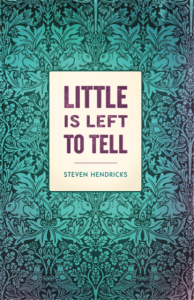 About Little Is Left to Tell
About Little Is Left to Tell• Print Length: 284 pages
• Publisher: Campanile Books
Little Is Left to Tell is the haunting novel by master fabulist Steven Hendricks. Enter a nocturnal world where the unreal is seen on a liminal horizon of fading memory, illuminated by partial understanding and lyrical fictions. Virginia the Wolf writes her last novel to lure her daughter home. A rabbit named Hart Crane must eat words to speak, while passing zeppelins drop bombs. Mr. Fin tries to read the past in marginalia and to rebuild his son from boat parts. A novel that bridges between dreamscape and reality, Little Is Left to Tell is entrancing and enthralling.
“In Little is Left to Tell one scene is quietly illuminated and then that illumination glides to the next, equally quiet and wondrous. Like a dream that inhabits an entire life, even a life of reading, this…
View original post 508 more words

February 24, 2016
Interview
Interview with Genevieve Randall, Friday Live
http://netnebraska.org/interactive-mu...
February 7, 2016
Goodreads Giveaway
Goodreads Book Giveaway
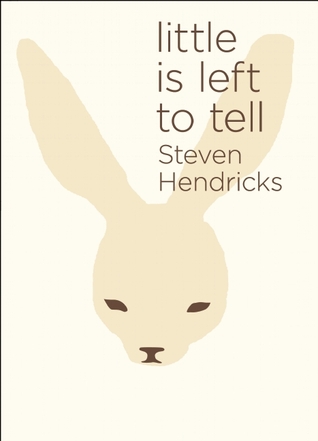
Little is Left to Tell
by Steven Hendricks
Giveaway ends March 15, 2016.
See the giveaway details
at Goodreads.
https://www.goodreads.com/giveaway/widget/172858

February 6, 2016
Goodreads Giveaway
Goodreads Book Giveaway

Little is Left to Tell
by Steven Hendricks
Giveaway ends March 15, 2016.
See the giveaway details
at Goodreads.
https://www.goodreads.com/giveaway/widget/172858

September 9, 2014
Little is Left to Tell has arrived!
July 23, 2014
Mr Fin woke up with an eye like a bag of wind…
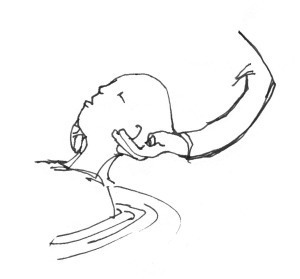 Mr Fin woke up with an eye like a bag of wind, like a lotus. He had slept the night in his chair, and his muscles were bitter.
Mr Fin woke up with an eye like a bag of wind, like a lotus. He had slept the night in his chair, and his muscles were bitter.
He walked. It was early, quiet. It must have been very early. Rosy fingertips, he said. Sing muse, he said.
He’d wandered all the way to the dock, where he admired the clicking of lines on the silvery pale masts dallying above the pier, wobbling on the purple waves below, proud, dumb ducks. Retreating back to land, he settled on one of his usual benches, looking out at the water. In the half-light, he was pressed against the world like his hand against a page, not reading. The tide brought line after line of foam.
When he felt a gravitational pull on his attention, on his body first, his mind and eyes trailed toward the water, toward an unwavelike, unloglike form sliding in on the ramshackle tide. Leaning forward, he tried to open his eyes, open again, really see.
If somehow one’s nerves could multiply and reach into all the miniature worlds of one’s organs and flesh, weaving among the molecules of fat and tissue, coursing ever more finely into the rush of blood and more still to weave into the non-places between protons, neutrons, and electrons, sending out excitable quantum whiskers, all charged with feeding the same storm of attention, one would seem to float, mist-like, more empty space than not, feeling not thicker but diffuse, light, feeling all the lack of contact within oneself and between oneself and the world, a phantom, an opening in space, a hovering idea.
When he saw the head, he knew. By his count, at that moment, knowing full well the day of the week and the week of the month, having counted in his head and many times worked things out on paper, he knew that it had taken twenty years, three months, and twelve days for his son’s body to wash ashore.
Mr Fin was little more than a perspective in space focused on the arrival of the head, the shoulder blades, appearing and disappearing in the unfolding water. He moved from the bench, not feeling his legs or his arms or his chest, susceptible only to the mutual tide of water and air, drawn to the coiling foam that gathered into itself, the infinite patience of the sea, until the sand broke the sway of his son’s body, and Mr Fin ran to the water’s lip.
He splashed into the water rushing up and back around his ankles, plying through loamy and sucking sand. He steadied himself, made himself strong, so he could reach down and hold the body still.
He lifted it into his arms and carried it up the hill…
(drawing by Meghan McNealy)

July 21, 2014
Hart Crane, happy birthday!
Today is the real Hart Crane’s Birthday..
In my novel, Hart Crane is a rabbit (think Harvey, and then don’t)…
Here is the time when Youngest Bear meets the rabbit Hart Crane..
…zeppelins loomed close in the evening air, maybe seven of them all in a group—Youngest had trouble getting a count as they crossed each other’s paths and turned through space. He was amazed and delighted by them. They lumbered through the sky, their attacking finished, they dawdled home, or to the next place, coasting restfully through the evening, and they were beautiful, so close to impossible. Youngest saw how their gray skin clung to them, walruses in the air, some tipping forward or backward as they flew, some twisting ever so slightly, as if to expose some part of their bellies or backs to the cool air, or to a warm draft, or to turn their strange eyes up toward the few stars that had leaked into the eastern blue evening.
Before they had passed from sight, the zeppelin in the lead made a booming call or siren sound, a signal. Within moments, they had all formed a triangle behind the leader, and they flew with more severity.
Then, as if it were part of the same maneuver, several of the zeppelins released something from their bellies, defecated really, and these turds tumbled from the sky, turning, odd-shaped things, and as several disappeared behind the tree-tops, Youngest thought that he could hear the slight thumps made as they landed. One of them came rushing down very near, and he saw it crashing into a treetop and plummet through the leaves, catching on branches, more like a sack of turd than a turd, which would simply break apart then crumble to the ground.
It wasn’t a turd at all, and as it raised itself from the ground, Youngest saw what it really was.
Hart Crane was now a different sort of rabbit. He had been eaten by an elephant, one of the zeppelins—war machines—monsters. It was a migration that voided memory, he would say, in the belly of inventions that stone the heart, an unspeakable bridge to spent suns, to the floating Atlantis of the sky, beyond time, where an arcing spear, bloodied by a toiling star (drained of its infinite flame—orphic strings mapped the sidereal phalanxes, auroras of pity, antiphonal whispers sucked through the gear-teeth of night and flung about by the blue flywheel of the ocean), gushed from the azure moon.
Such was his soliloquy as he stumbled from the trees, sputtering, chilled to the naked bone. He saw the house of the three bears, he saw his own paws, hands, and he heard the brushing of his strange legs moving queer in the drying leaves. He was naked, but unashamed. He pronounced to the trees still around him, though it seemed to him they were dispersing or gathering behind him, he orated to them, because here was a world that seemed, to him, for the moment, void of idea, void of names…
He was astounded that his words did not follow his will, or if they did it was in some secret way, so to speak of his confusion, the difficulty of gathering what had happened these last few days, he said, “So was I turned about and back, much as your smoke compiles a too well-known biography? That evening spear was the river… and have I walked the dozen decimals of time? My memory I left in a ravine—among apron rocks, congregated pears in moonlit bushels—and only wakes in an alley of trees, a trough beneath a glittering abyss—the abyss is a serpent sunning itself, drumming its tongue against the not-abyss, the fountain: what icy speech through the walls? What rustle of scales, of water, of paper: memory committed to a broken page.”
When he was done speaking, he heard the young bear’s weak summons. He wandered to him, and without question or greeting, joined him, leaning sleepily against the stone beside him, as if that were all there was left to do.
Little bear said to him, much later, when they both happened to be awake, “They took my books.” He let a tear tip from his eyelid as if on command but without further expression, not to let emotion tire the body.
Hart said softly, like the last lines of a bedtime story, “I think the air has thrown itself upon me and been answered, at least in part, and I believe I am a little changed—not essentially, but changed and transubstantiated as anyone is who has asked a question and been answered. Now the form of my life rises out of a past that so overwhelms the present with its mutant shades and visions that I am at a loss to imagine real links between that past and any future at all.” He tried to meet Little bear’s eyes.
Little Bear’s eyes showed delight, and he said, “I’m so glad you’re here with me. You are more book than rabbit!”
Hart said, in agreement, “The bottom of the sea is cruel…’” and he went on and on.
When Hart fell quiet they both slept, although, in general, Littlest would have found it hard to determine what was sleeping and what was waking as they sat together, so peaceful was he, and so delightful a calmative were the words and stories Hart recited. He seemed to do it, tell stories, the way one hums a tune—unconsciously, following the breath, wandering wherever, perhaps thinking his own very different thoughts as the stories scrolled pillars and bridges from his mouth.

July 19, 2014
Virginia the Wolf
drawing by Meghan McNealy
Here’s a bit from the novel, Little is Left to Tell, by Steven Hendricks coming out in September from Starcherone Books.
Help Starcherone (non-profit independent publisher) promote this work to the world…
CHAPTER SEVEN
THE SUN SINKS. One sees landscapes encircling creatures who want only to leave this cold night. I have resisted grain and water enough to die before the week is out. I disperse like angels around a grave. Solemn rail, it sheds black hair, such feet, such a purse, hairy cheeks, a pacifist’s chin, before a banquet of dust. …in slippery satin, sea-green women condemn me… a square upon the oblong… here are the stones that wither beside the smooth stream, where fish sink, sea-smitten, almost gods, bearing fruit and blossom. I take them from you, mended to the sky and to the distant shores, my fortune, my fortune of stones. I watch the cool wells, I walk the roads. I will remain in this landing between stairs, looking out upon dead lands, where nothing moves. I will hold on, I will not let go. I will consume and be consumed. From the air that forms in the heart of the earth, into the air that forms the breath of me, I cast my stones, my curses.
Virginia the Wolf was a fractal. If one looked closely (if one were able) at the composition of her flesh, one would find them, hundreds, millions of wolfish jaws gaping, and there in their throats, a veritable plague of bacteria-like Virginias, smaller than small and wandering about, prowling and sinister ornaments that knew all she knew, waiting in their own wild orbits. Every moment, a nation of them was sloughed off, scraped against a wall, shaken into the distance when she was cold, when she scratched, and they formed infinitesimal piles of life all over the house and grounds—every moment, yet they would never be used up. The whole world might already be filled with her, inside and out.
So, to meet her was to meet an earthly deity, though her manner was restrained, even withdrawn. Withdrawn as she sat at the window as if waiting; withdrawn as she did her typing, in the early dawn before breakfast and from the close of supper until darkness had risen. The deity appreciated the echo of her own slow keystrokes. She gave her commands to the elders among her many servants, who all obeyed a formalism of task and communication that kept them occupied: this, that. The few with whom she spoke hovered on her words, as if her breath were delicious viscera. Picture them in brown, male or female, shiny as Labradors but with noble, dispassionate eyes. Many of her commands, she would admit, were useless, that is, they were already the daily machinations of the house and grounds, but in maintaining her right to command the details, to alter them slightly, to be the finest but most decisive gear in the watch-works, she maintained her authority in the house and her right to anger at whatever she pleased.
*
(opening section transmuted from a passage in The Waves, by Virginia Woolf)

July 16, 2014
Zero-action animation brings novel to life!
Here is a link to a short video playing with the opening of my novel, Little is Left to Tell, coming out this September from Starcherone Books:
All the Children of Mrs. Rabbit… (youtube video)
If you want to support Starcherone in the release of the novel, visit their Kickstarter Campaign.
Thanks!



